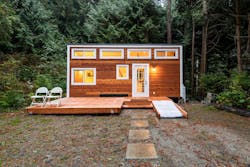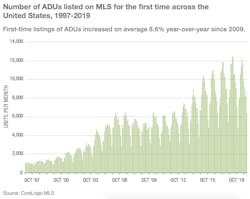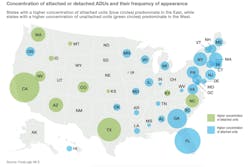The rise of ADUs in the United States has been meteoric. There’s no question about that. But a recent study from Freddie Mac in which researchers meticulously combed through decades of MLS data (i.e., the multiple listing service, where all for sale homes are posted) shows the rise may have been more gradual than we think. It also gives clear details on the prevalence of ADUs in the country today.
We worked our way through the report to find its five biggest reveals.
ADUs go by many names
With access to historical MLS data, researchers looked for evidence of ADUs as far back as 1997 andWhile some of the terms used were commonplace, like “carriage house” and “in-law suite,” others were more niche, like “granny flat” and “second master.”
Accounting for the dozens of terms used to describe ADUs, evidence of 1.4 million ADUs was ultimately uncovered.
The flaws of previous studies
In explaining its methodology, Freddie Mac researchers point out in their report that while previous studies on ADU prevalence have relied on permit data, that information is dubious. “Conclusions on these results should be read with caution because the data is recordings permits issued, not actual completions,” the report reads.
Furthermore, ADUs are unique in that they are structures that are often erected despite the absence of a permit. Those types of ADUs are called “shadow housing” and they may represent the majority of ADUs. For instance, in 2011 a University of California survey of San Francisco Bay Area homeowners revealed that 90% of the ADUs identified “lacked required building permits.”
ADU growth has indeed been serious
At the turn of the century, ADUs were being touted in 1.6% of active for-sale listings. Today, it’s 6.8%.
In the 10 years between 2009 and 2019, year-over-year growth of first-time listings of ADUs averaged 8.6%. As of last year, 70,000 active for-sale listings featured ADUs.
Accounting for all the data Freddie Mac collected, no state has had more ADUs than California, Florida, Texas, and Georgia—which all have cumulatively had over 100,000. But looking just at the ADUs since 2015, it’s the northwest that shows the most surprising growth. ADUs in the Portland area have averaged a year-over-year growth rate of 22.3%.
Attached or detached? A pattern emerges
There are two basic ways to build an ADU: attached to the main structure and separate from the main structure. The decision to go one way or another may seem a question of preference, but looking at mapped data a pattern is clear: detached ADUs in the West, attached in the East.
Density is the differentiator. The Eastern US is older. People have been building and building for years, and packing cities so tight that having a lot large enough to include a detached unit is simply not an option for a lot of homeowners. However, in the West, where cities tend to be more sprawling and lots tend to be more open, it is an option; and so they choose to have a separate structure.
About the Author

James F. McClister
James McClister is managing editor for Professional Remodeler.




